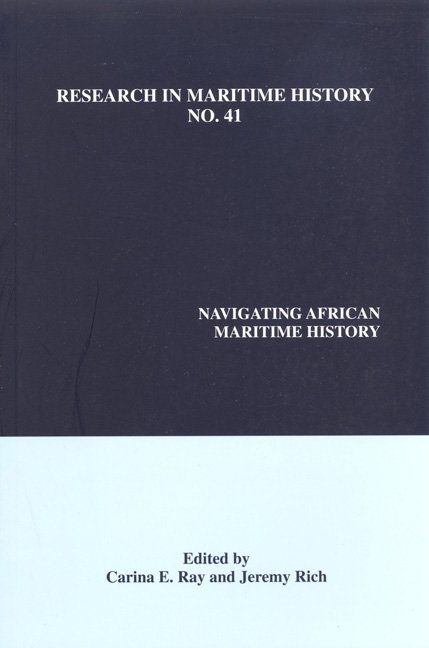Book contents
- Frontmatter
- Table of Contents
- About the Editors
- Contributors' Notes
- “Introduction: Charted Routes and New Directions in the Study of Africa's Maritime History”
- “Austronesian Mariners and Early Trans-Indian Ocean Crossings”
- “Eight Hens per Man per Day: Shipwreck Survivors and Pastoral Abundance in Southern Africa”
- “State Control and Regulation of Commerce on the Waterways and Coast of Senegambia, ca. 1500-1800”
- “Swimming, Surfing and Underwater Diving in Early Modern Atlantic Africa and the African Diaspora”
- “Rough Sailing: Risks and Opportunities for Immigrant African Maritime Workers in Gabon, ca. 1860-1914”
- “Desertion, Dereliction and Destitution: The Travails of Stranded West African Seamen in the United Kingdom, ca. 1921-1934”
- “‘The White Wife Problem:’ Sex, Race and the Contested Politics of Repatriation to Interwar British West Africa”
- “Sailing Beyond Apartheid: The Social and Political Impact of Seafaring on Coloured South African Sailors”
“Swimming, Surfing and Underwater Diving in Early Modern Atlantic Africa and the African Diaspora”
- Frontmatter
- Table of Contents
- About the Editors
- Contributors' Notes
- “Introduction: Charted Routes and New Directions in the Study of Africa's Maritime History”
- “Austronesian Mariners and Early Trans-Indian Ocean Crossings”
- “Eight Hens per Man per Day: Shipwreck Survivors and Pastoral Abundance in Southern Africa”
- “State Control and Regulation of Commerce on the Waterways and Coast of Senegambia, ca. 1500-1800”
- “Swimming, Surfing and Underwater Diving in Early Modern Atlantic Africa and the African Diaspora”
- “Rough Sailing: Risks and Opportunities for Immigrant African Maritime Workers in Gabon, ca. 1860-1914”
- “Desertion, Dereliction and Destitution: The Travails of Stranded West African Seamen in the United Kingdom, ca. 1921-1934”
- “‘The White Wife Problem:’ Sex, Race and the Contested Politics of Repatriation to Interwar British West Africa”
- “Sailing Beyond Apartheid: The Social and Political Impact of Seafaring on Coloured South African Sailors”
Summary
Long before the Portuguese ventured down the West African coast, many Africans had become skilled swimmers, divers and surfers. In one of their first recorded encounters, the Portuguese were amazed by the swimming and underwater diving abilities of the Africans. The Portuguese navigator Joäo Gonçalves Zarco noted that his men had considerable difficulty capturing Senegambian canoemen after they leaped into the water to avoid capture, saying “our men had very great toil in the capture of those who were swimming, for they dived like cormorants, so that they could not get hold of them.“ Slaves’ expertise in underwater diving, moreover, was one of the first African skills that New World slaveholders exploited, in the process generating considerable profit. At the turn of the seventeenth century Pieter de Marees explained that Venezuelan slaveholders sought Gold Coast Africans to employ as pearl divers, noting:
[t]hey are very fast swimmers and can keep themselves underwater for a long time. They can dive amazingly far, no less deep, and can see underwater. Because they are so good at swimming and diving, they are specially kept for that purpose in many Countries and employed in this capacity where there is a need for them, such as the Island of St. Margaret in the West Indies, where Pearls are found and brought up from the bottom by Divers.
From the Age of Discovery through the nineteenth century, the swimming and underwater diving abilities of people of African descent usually surpassed those of Westerners. Indeed, sources indicate that most whites, including sailors, could not swim. To reduce drowning deaths some philanthropists, beginning in the mid-nineteenth century, advocated that sailors and others learn to swim as a means of self-preservation. Theodorus Mason's 1879 pamphlet, The Preservation of Life at Sea, stressed that “[t]he great majority of people cannot swim, and strange as it may seem to you, there are many who follow the sea as a profession who cannot swim a stroke.” Mason then urged that as part of their instruction all US Naval Academy cadets should be taught to swim.
- Type
- Chapter
- Information
- Navigating African Maritime History , pp. 81 - 116Publisher: Liverpool University PressPrint publication year: 2009



